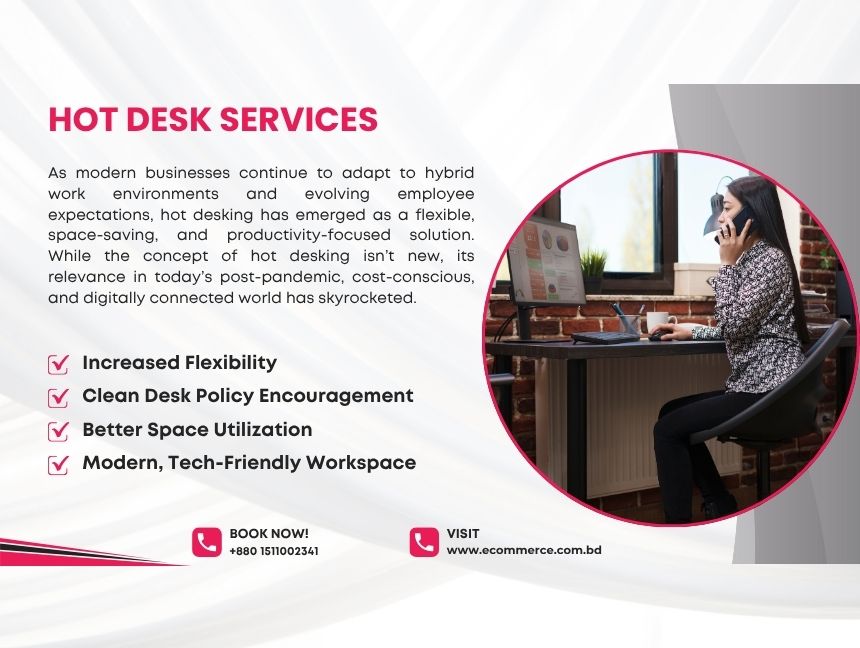




As modern businesses continue to adapt to hybrid work environments and evolving employee expectations, hot desking has emerged as a flexible, space-saving, and productivity-focused solution. While the concept of hot desking isn’t new, its relevance in today’s post-pandemic, cost-conscious, and digitally connected world has skyrocketed.
Whether you’re a startup looking to optimize limited office space, or a large enterprise aiming to implement an agile workspace strategy, understanding the advantages and disadvantages of hot desking is crucial.
Now we’ll explore what hot desking is, how it works, its benefits and drawbacks, and how you can implement it effectively—step by step.
Hot desking is a flexible office setup where employees do not have assigned desks. Instead, workspaces are available on a first-come, first-served basis or through booking systems. It’s particularly effective in hybrid work environments where not all employees are present in the office every day.
Unlike traditional fixed seating, hot desking relies on mobility, cloud access, digital collaboration tools, and efficient space management.
Hot desking is popular among:
Before adopting hot desking, ask:
Assess how your current office space is used. Consider:
There are several models of hot desking:
Hot desking impacts workplace behavior. Educate and train your staff on:
Pilot hot desking with one team or department. Gather feedback and tweak the setup before a company-wide rollout.
One of the biggest advantages of hot desking is reduced overhead costs. Organizations can downsize office space without compromising on productivity.
Hot desking promotes a culture of adaptability. Employees can:
Since employees are not fixed to a single desk or department, they naturally interact with a broader group of colleagues.
A clean desk policy is central to hot desking. Employees are encouraged to:
Hot desking complements remote and hybrid work models by allowing fewer desks for a larger workforce.
Implementing hot desking pushes companies to invest in digital infrastructure, which often leads to better IT integration.
Employees lose the personal touch that comes with a dedicated workspace. This can affect comfort and satisfaction.
Without a structured booking system, employees may:
In open seating areas, employees might struggle to find quiet spaces, especially for:
Shared workspaces can spread germs. Post-pandemic, cleanliness is a bigger concern.
Employees may face setup difficulties every day:
If team members are scattered daily, it can:
In countries like Bangladesh, hot desking is gaining popularity in:
Platforms like Ecommerce.com.bd now offer structured hot desking services—from tech-enabled seating systems to space design, digital bookings, and hygiene management—tailored to meet the evolving needs of Bangladeshi businesses.
To make hot desking work effectively:
Hot desking is not a one-size-fits-all solution. Before adopting it, ask:
If yes, then hot desking may be a smart, future-ready move.
At Ecommerce.com.bd, we specialize in creating efficient, scalable, and affordable hot desking solutions for businesses of all sizes.
Our services include:
Whether you’re redesigning your office or launching a co-working space, our experts will help you build a productive, flexible workspace tailored to your team’s needs.
Hot desking is more than just a space-saving trend—it’s a strategic approach to workplace management that empowers modern businesses. While it brings impressive benefits like cost savings, flexibility, and collaboration, it also comes with challenges such as reduced personalization and privacy issues.
By carefully evaluating its fit for your company and using the right tools and practices, hot desking can transform how your team works and interacts.
If you’re ready to embrace the future of flexible workspaces, Ecommerce.com.bd is your trusted partner in building a smart hot desking solution.
The key benefits include cost savings, better space utilization, enhanced collaboration, support for hybrid work, and cleaner, more organized workspaces.
Hot desking can boost productivity when implemented with proper planning, booking tools, quiet zones, and a clean desk policy.
Hot desking refers to shared desk use within the same organization, while co-working typically involves shared office space among different individuals or companies.
Employee opinions vary. Some enjoy the flexibility, while others miss the comfort and personalization of a dedicated workspace.
Start with space assessment, choose a booking system, set usage rules, train employees, and invest in technology and storage solutions.